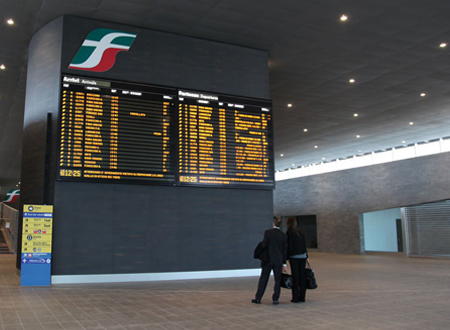Public information on railway timetables and train performance, which is essential for passengers being able to use the rail services, is distributed primarily in stations and is constantly being improved in terms of technology, organisation and communication strategies. On the web with up-to-date information on travel with Travel Information, on the trains arriving and departing station by station with the Live Departures/Arrivals Monitor and on the scheduled timetable with the Online Timetables

Public information in stations is one of the areas of activity in which RFI commits significant resources and professionalism to raise the quality of the service, both from a technological and instrumental point of view, by continuously improving "intelligent" technologies able to translate the data received from traffic control systems into audio and visual information, and from an organisational and communication strategy point of view, by adopting new models for managing the flow of data to be disseminated and more direct and effective ways of presenting the information.
At stations, there are two types of public information:
● fixed information on getting around the station and safety information, as well as information on scheduled train timetables, is conveyed by means of signs and wall-mounted timetable boards indicating the arriving and departing trains by time slot.
● variable information in real time on the actual time and track of arrival and departure of trains and for communicating any travel abnormalities (delays, cancellations, strikes, etc.), conveyed by audio and visual channels through audio devices, monitors and LED boards and carriage indicators.
The choice of the various means and channels to be used in the various cases depends on the characteristics of the station in terms of traffic, building structure, type and quantity of traffic and services offered.
Among the many improvement measures implemented to raise the quality and methods of public information to a uniform standard, we are progressively implementing a cutting-edge technological system throughout the network, the IeC (Information and Communication) system. Borrowing from traffic management models, this system allows all information relating to the same train to be distributed at the same time from a "central post" to all stations connected to it, reducing both the chain of operators involved in the process of data processing and distribution and the number of operations to be carried out manually. With the new system, the operator has more space to add value to the information already available automatically, for example by supplementing it - in the event of delays or cancellations - with information on possible alternative journeys, to be displayed on the monitors alongside the other data which until now could only be conveyed by sound announcements..
In addition to developing increasingly advanced ICT systems capable of increasing the timeliness and accuracy of information, we are constantly striving to improve the tools and methods of presenting audio messages to make them clearer, more effective and more user-friendly. We have been already been making steps in this direction since 2004 with the 1st edition of the Manual of Sound Announcements (MAS), drawn up together with the Linguistics Department of the La Sapienza University of Rome, now in its 3rd edition, on the basis of which both the automatic announcements, generated by the traffic data "captured" along the lines, and the messages disseminated by the operators are constructed.
The same efforts are also being made to improving the quality of visual information in stations. As well as replacing monitors and other display peripherals currently under way at national level, measures are being taken which are tailored to the size and characteristics of the various stations. The most recent include: in stations in metropolitan areas with local public transport (LPT) services, the installation along the tracks of carriage position indicators, similar to those in use for high-speed trains, aimed at facilitating and speeding up boarding; also for LPT travellers, the provision of information on alternative travel options in the event of delays to the expected train; for major stations, the positioning of large monitors to make arrival and departure messages more visible; for stations where several modes of transport converge, fixed and variable indications to facilitate interchange between the various modes.
Cancelled train? Long delay? Difficulties buying a ticket? Problems with train and station accessibility?